Old Buildings – New Life
Learning Objectives:
- Identify and recognize the significance of renovating existing buildings for adaptive reuse to achieve safety, wellness, and sustainability.
- Assess the health and wellness aspects of incorporating usable outdoor spaces such as decks, balconies, and pop-up parks in existing buildings.
- Explain the importance of good bathroom/restroom upgrades to meet current health, safety, accessibility, and sanitation standards in renovation projects.
- Determine ways to incorporate the health, safety, and economic planning principles presented into renovated buildings as shown in case studies.
Credits:
This course is approved as a Structured Course
This course can be self-reported to the AANB, as per their CE Guidelines
Approved for structured learning
Approved for Core Learning
This course can be self-reported to the NLAA
Course may qualify for Learning Hours with NWTAA
Course eligible for OAA Learning Hours
This course is approved as a core course
This course can be self-reported for Learning Units to the Architectural Institute of British Columbia
It has often been pointed out that the most sustainable building is an existing one. That is because existing building renovations typically require less new material with less embodied energy than totally new construction. Beyond that, some older buildings are constructed with a quality of materials or craftsmanship that is simply not available or economically viable today. In light of all of these things, adapting and re-designing an existing building for a new or different use continues to be a common and sought-after approach to accommodate a wide range of building types. Brick warehouses are transformed into loft-style apartments; former churches are re-purposed into restaurants; pre-WWII school buildings become senior living centers; old factories are turned into offices and business incubators. When multiple buildings are thus transformed, entire neighborhoods or whole cities become more vibrant, diverse, and marketable. Architects and other design professionals engaged in this creative and transformative work often use conventional products and systems in innovative ways to give new life to older buildings. This course looks at two particular areas that can be overlooked in any building renovation or adaptive reuse – specifically the creation of usable and attractive outdoor spaces on existing buildings and the upgrade of plumbing systems within existing walls. Examples are offered of several ways this has been done successfully, economically, and sustainably.
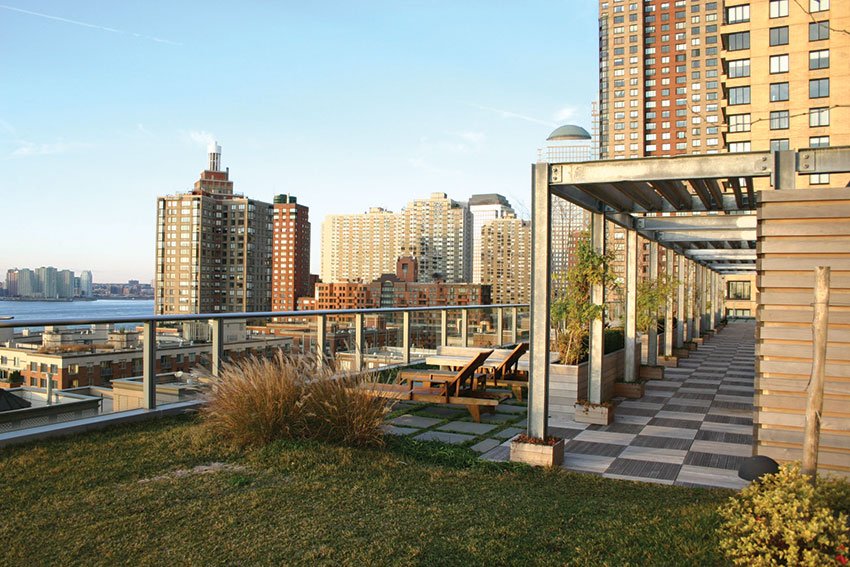
Photo courtesy of Bison Innovative Products
Existing buildings provide great opportunities for creating vibrant, appealing, and sustainable designs.
SITE ADAPTATION
Older buildings sit on their own building site and have their own context that is usually well established. However, there are often outdoor areas that are underutilized or rooftop surfaces that have been ignored. These spaces have the potential to enliven a renovated building by providing outdoor community spaces or living areas.
Incorporating outdoor spaces into a building renovation or adaptive reuse is consistent with many current trends and can go a long way toward improving the design character and usability of the building. Often this can be accomplished without impacting any of the historic nature of the building itself. Some of the design trends to consider in this regard include the following.
- Biophilic Design: This concept is described as "the deliberate attempt to translate an understanding of the inherent human affinity to affiliate with natural systems and processes, known as biophilia, into the design of the built environment.” As is evident in many current and recent building projects, there are many ways to incorporate biophilic elements into a building’s design. It can be done through a visual connection to the outdoors, the incorporation of natural elements indoors, or expanding the indoor spaces to flow into outdoor spaces. Creating outdoor spaces can achieve this indoor/ outdoor environmental connection not only by physical proximity but also through the use of natural materials and vegetation. This can include designing with natural wood and stone and incorporating vegetation and greenery through the use of planters and flower pots. The advantages of biophilic design are based on regular interactions with the outdoors, which are proven to have positive health benefits, such as lower blood pressure, reduced stress, expedited healing, and improved mood and focus.
Something fairly straightforward, such as an outdoor deck, patio, or balcony, can provide living spaces with a direct visual and material connection with nature and a peaceful refuge to rejuvenate the body, mind, and soul. A deck’s sweeping views of the encircling landscape can provide users the opportunity to survey and contemplate the surrounding environment. Such broad landscape views inspire an emotional attachment to the building’s natural surroundings and promote positive interactions between the building users and the neighboring ecosystem. Well-designed outdoor areas provide occupants with the opportunity to release tension through separated respites or through sport and physical activity, thereby improving users’ focus, health, and morale.
- Green Roof Decks: There has been a trend to transform roof areas, particularly in urban settings, into environmentally beneficial and people-friendly places. This includes creating “green roofs” which can provide shade to a building or people, improve stormwater management, reduce temperatures of the roof surface and surrounding air, and reduce energy demands on the building as a result. Such designs and related products can also help mitigate the built environment’s contribution to urban areas’ heat island effect. When a green roof is built on top of a raised deck system, it creates an air space between the deck and the building roof structure. This cavity space can help reduce cooling loads, protect the roof and its membrane from damage from the elements (hail, wind, and UV rays), and significantly extend its lifespan.
- Pop-Up Parks: There has been an ongoing trend to reclaim car-designated zones in urban areas and transform them for pedestrian or hospitality and entertainment use. The result has been the use of “pop-up parks” which can vary in size from a one-car parking space of about 150 square feet to many spaces linked together to a whole block or lane. Such pop-up parks can be considered in adaptive reuse building renovations allowing for temporary installations for events, for seasonal use, or even permanent year-round use.
All of these trends can be useful for an adaptive reuse building renovation. However, there are often construction issues to address such as the lack of a level ground or roof deck surface, the need to easily incorporate natural materials and plantings, and an eye toward working within project budget restraints.
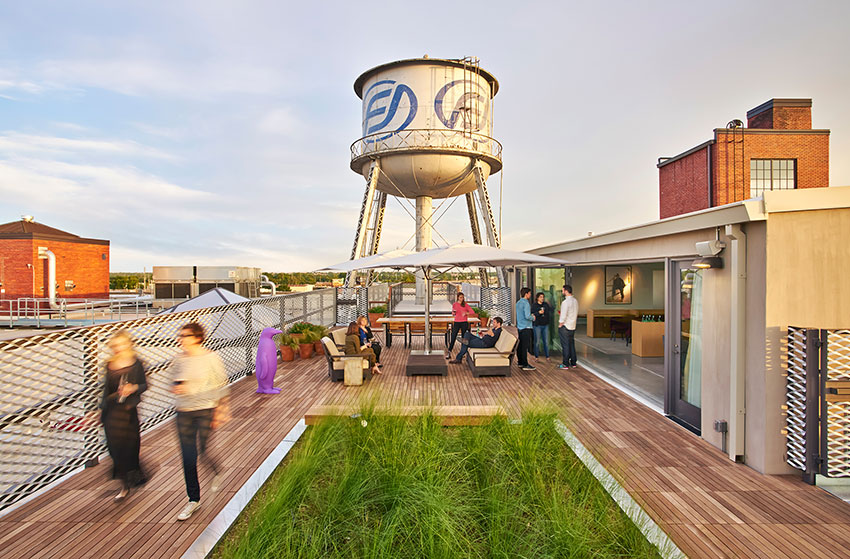
Photo: Mike Schwartz; courtesy of Bison Innovative Products
Reclaiming unused space in existing buildings, such as this rooftop area, allows for the creation of outdoor spaces with many health and wellness benefits to the users.
Raised Modular Decks
A commonly available solution to addressing all of these design trends in building renovations or re-use is the incorporation of a raised modular deck system. Such modular systems are versatile and give architects and others the design flexibility to create unique and beautiful rooftop environments and outdoor spaces. By utilizing adjustable height pedestals to support the deck, uneven or sloped surfaces can be easily accommodated. This creates the opportunity to use underutilized outdoor spaces and turn an otherwise wasted space into a functional outdoor amenity, such as a kitchen, bar, lounge, or garden area. Rooftop decks help to boost morale and strengthen relationships within the community of building users. They can also incorporate natural elements such as planters or natural materials and thus create biophilic design opportunities within a renovation.
Incorporating a pedestal deck system can also provide pedestrian access to green roofs. Native plants and natural building materials offer occupants a visual and material connection with nature. Green spaces benefit occupants’ health and wellness by enabling programmatic flexibility; these spaces can be used for recreation, refuge, and/or restoration. Modular planters provide a space for seasonal growing, giving building users a direct interaction with nature and a connection to food supply and seasonal patterns.
Green roof systems can incorporate rooftop deck components such as wood tiles and planter/cube tops with high solar reflectance index (SRI) values—an indication of the material’s relative ability to stay cool (reject solar heat), reducing heat flow into the building. Designs can include recessed lighting to enhance the ambiance of the environment and improve visibility during nighttime and/or dark conditions. An adjustable pedestal system is also an ideal solution for water feature applications. The system conceals the water supply beneath the surface materials and allows water to drain to the surface below for recycling. Additionally, the deck supports are impervious to water, mold, freeze-thaw cycles, and most chemicals.
Adjustable pedestal deck systems are also ideal for pop-up park installations that can include wood tile, stone, or concrete paver surfaces covering the existing pavement. Popular accessories include attachment hardware, planters, railing, and benches. Some manufacturers offer all the built elements required for a pop-up park installation which creates a smooth installation as well as offering a consistent warranty for the entire system.
PLUMBING MODERNIZATION
enovating or modifying an existing building, particularly an older building, means addressing ways to upgrade the mechanical, electrical, and plumbing (MEP) systems to meet current standards and user expectations. That often creates challenges in a number of ways including the following:
Use the Existing Building Shell: Architects can be faced with the need to meet current code requirements and apply them to existing (often historical) renovated buildings, particularly if there is a change of use or occupancy. Yet there may also be preservation or budget requirements that limit the work that can be done in existing buildings. Hence, there is often a strong need to find ways to upgrade MEP systems by working within the existing structural walls of a building.
Compact Plumbing Chase or MEP Walls: Space is often at a premium in renovation projects as new user programs try to work within existing geometries. There may also be a requirement from building owners to make as much square footage usable or rentable as possible without encroachment from utilitarian things such as plumbing chases or walls enlarged to carry MEP lines. Finding ways to achieve this can be as much a matter of design as it is a matter of selecting space-saving MEP systems.
More Spacious Rooms: Updating buildings often means finding ways to make rooms and interior areas more spacious and open. That leads to different approaches, not only related to moving walls, but also to finding ways to minimize the footprint and space taken up by MEP fixtures and equipment.
Accessibility: Older buildings often aren’t fully accessible by current standards. That may mean addressing accessible routes, both horizontal and vertical, as well as updating things like bathrooms and other spaces that have specific accessibility requirements. Bathroom fixtures and heights become important in this case not only for commercial applications, but also for residential projects where the concept of “aging in place” may be part of the design criteria.
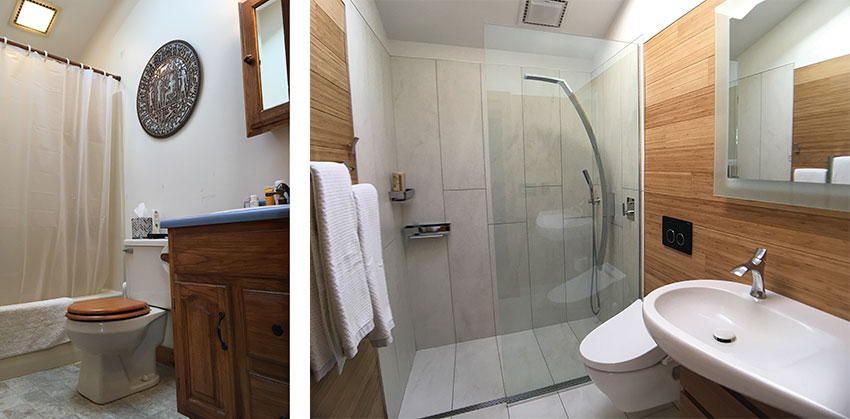
Photo courtesy of Geberit
Bathroom renovations, such as the one shown here at a Vermont ski resort can improve water efficiency, save floor space, and create a cleaner, updated look.
Any one or all of these aspects of a renovation design may be a primary or secondary part of the design challenge for a particular building. Keeping an open mind and looking at different options as they become available can go a long way toward finding good solutions.
In-Wall Mounted Toilet Systems
A good example of how to address all of these MEP renovation and design upgrade questions is by looking at bathrooms or restrooms in an adaptive reuse/ renovated building. Often, the existing conditions restrict the amount of available floor space to make upgrades, particularly when it comes to accessibility requirements. One solution that has worked quite well is installing wall-hung toilets using a wall-recessed mounting system. These are readily available and have been the norm in many European countries for many decades. They are now gaining significant traction for use in the United States as well.
Notice
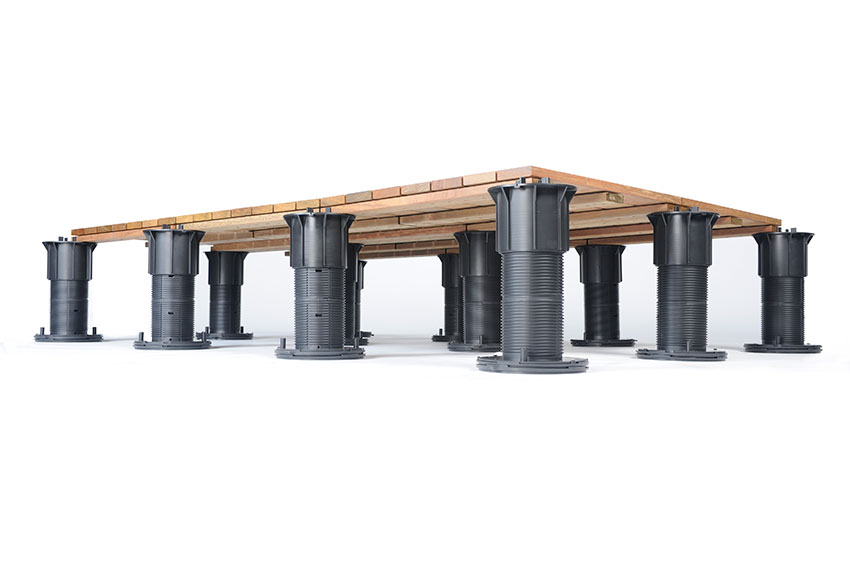
www.bisonip.com
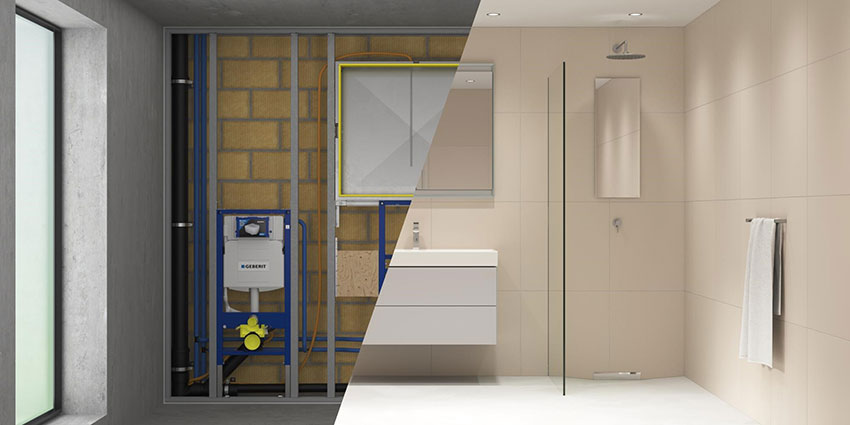
www.geberit.us



















